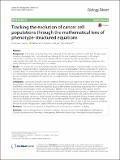Tracking the evolution of cancer cell populations through the mathematical lens of phenotype-structured equations
Abstract
Background: A thorough understanding of the ecological and evolutionary mechanisms that drive the phenotypic evolution of neoplastic cells is a timely and key challenge for the cancer research community. In this respect, mathematical modelling can complement experimental cancer research by offering alternative means of understanding the results of in vitro and in vivo experiments, and by allowing for a quick and easy exploration of a variety of biological scenarios through in silico studies. Results: To elucidate the roles of phenotypic plasticity and selection pressures in tumour relapse, we present here a phenotype-structured model of evolutionary dynamics in a cancer cell population which is exposed to the action of a cytotoxic drug. The analytical tractability of our model allows us to investigate how the phenotype distribution, the level of phenotypic heterogeneity, and the size of the cell population are shaped by the strength of natural selection, the rate of random epimutations, the intensity of the competition for limited resources between cells, and the drug dose in use. Conclusions: Our analytical results clarify the conditions for the successful adaptation of cancer cells faced with environmental changes. Furthermore, the results of our analyses demonstrate that the same cell population exposed to different concentrations of the same cytotoxic drug can take different evolutionary trajectories, which culminate in the selection of phenotypic variants characterised by different levels of drug tolerance. This suggests that the response of cancer cells to cytotoxic agents is more complex than a simple binary outcome, i.e., extinction of sensitive cells and selection of highly resistant cells. Also, our mathematical results formalise the idea that the use of cytotoxic agents at high doses can act as a double-edged sword by promoting the outgrowth of drug resistant cellular clones. Overall, our theoretical work offers a formal basis for the development of anti-cancer therapeutic protocols that go beyond the ‘maximum-tolerated-dose paradigm’, as they may be more effective than traditional protocols at keeping the size of cancer cell populations under control while avoiding the expansion of drug tolerant clones.
Citation
Lorenzi , T , Chisholm , R H & Clairambault , J 2016 , ' Tracking the evolution of cancer cell populations through the mathematical lens of phenotype-structured equations ' , Biology Direct , vol. 11 , 43 . https://doi.org/10.1186/s13062-016-0143-4
Publication
Biology Direct
Status
Peer reviewed
ISSN
1745-6150Type
Journal article
Description
This work was supported in part by the French National Research Agency through the “ANR blanche” project Kibord [ANR-13-BS01-0004].Collections
Items in the St Andrews Research Repository are protected by copyright, with all rights reserved, unless otherwise indicated.
Related items
Showing items related by title, author, creator and subject.
-
Persistent paramyxovirus infections : in co-infections the parainfluenza virus type 5 persistent phenotype is dominant over the lytic phenotype
Randall, Richard E.; Young, Dan F.; Hughes, David J.; Goodbourn, Steve (2023-11-14) - Journal articleParainfluenza virus type 5 (PIV5) can either have a persistent or a lytic phenotype in cultured cells. We have previously shown that the phenotype is determined by the phosphorylation status of the phosphoprotein (P). ... -
The phenotypic plasticity of whole animal and muscle performance during fast-starts in Cottidae
Temple, Genevieve Kate (University of St Andrews, 1998) - ThesisChapter 1. Fast-starts are used by most fish species in order to capture prey and escape predators. An introduction to this mode of fish locomotion and the structure and function of the muscle powering swimming movements, ... -
Phenotypic discrimination of Mycobacterium tuberculosis by Raman spectroscopy
Baron, Vincent (University of St Andrews, 2018-06-29) - ThesisTB remains a major health issue worldwide causing around 1.5 deaths each year. The recent phase III clinical trials of shortened TB treatment failed to show superiority compared to the current regimen and this mainly because ...

